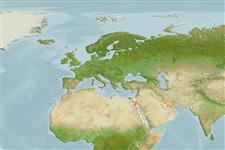>
Gobiesociformes (Clingfishes) >
Gobiesocidae (Clingfishes and singleslits) > Diademichthyinae
Etymology: Lepadichthys: Greek, lepas, -ados = limpet + Greek, ichtys = fish (Ref. 45335); erythraeus: From the Greek for red, in reference to the Mare Erythraeum, an ancient name for Red Sea (Ref. 42101).
More on authors: Briggs & Link.
Environment: milieu / climate zone / depth range / distribution range
Ecologia
marinhas demersal; intervalo de profundidade 1 - 3 m (Ref. 103877). Tropical
Western Indian Ocean: Red Sea, from the Gulf of Aqaba and Gulf of Suez, south to Al Wajh (northeastern Saudi Arabia).
Tamanho / Peso / Idade
Maturity: Lm ? range ? - ? cm
Max length : 3.7 cm SL macho/indeterminado; (Ref. 42101)
Descrição suscinta
Morfologia | Morfometria
Espinhos dorsais (total): 0; Raios dorsais (total): 15-16; Espinhos anais 0; Raios anais : 13; Vértebras: 34. This species is distinguished by the following characters: a membrane joining dorsal and anal fins with the caudal fin; the anus is closer to anal fin than to disc, about two-thirds the distance from the rear margin of the disc to the origin of anal fin; upper attachment of gill membrane opposite ninth pectoral-fin ray; second gill arch with 8 rakers; postdorsal-caudal distance 6.4-7.3 in dorsal-fin length; D 15-16; A 13; pectoral-fin rays 26-28 (rarely 28); principle caudal-fin rays 12; total caudal-fin rays 20 (Ref. 103877).
Specimens were collected from the base of a coral block on a reef flat with mixed sand and flat rock with patches of dead corals, from within live coral head in a sheltered bay, from a fringing reef at a depth of 1-3 m and from an isolated coral block. All were collected in close association with sea urchins of the genus Diadema, utilizing the long spines for shelter (Ref. 103877).
Ciclo de vida ou comportamento de acasalamento
Maturidade | Reprodução | Desova | Ovos | Fecundidade | Larvas
Oviparous, distinct pairing during breeding (Ref. 205).
McAllister, D.E., 1990. A working list of fishes of the world. Copies available from D.E. McAllister, Canadian Museum of Nature, P.O. Box 3443, Ottawa, Ontario K1P 6P4, Canada. 2661 p. plus 1270 p. Index. (Ref. 27116)
Status na Lista Vermelha da UICN (Ref. 130435)
Ameaça para os humanos
Harmless
Uso pelos humanos
Mais informação
Idade/TamanhoCrescimentoPeso-comprimentoComprimento-comprimentoFrequências de comprimentoMorfometriaMorfologiaLarvasDinâmica larvalRecrutamentoAbundânciaBRUVS
ReferênciasAquaculturaPerfil para aquaculturaEstirpesGenéticaElectrophoresesHereditariedadeDoençasProcessamentoNutrientsConversão de massa
ColaboradoresFotosStamps, Coins Misc.SonsCiguateraVelocidadeTipo de nataçãoÁrea branquialOtólitosCérebrosVisão
Ferramentas
Relatórios especiais
Baixar XML
Fontes da internet
Estimates based on models
Preferred temperature (Ref.
123201): 23.5 - 27.7, mean 26.1 °C (based on 72 cells).
Índice de diversidade filogenética (Ref.
82804): PD
50 = 0.5005 [Uniqueness, from 0.5 = low to 2.0 = high].
Bayesian length-weight: a=0.00389 (0.00180 - 0.00842), b=3.12 (2.94 - 3.30), in cm total length, based on all LWR estimates for this body shape (Ref.
93245).
Nível Trófico (Ref.
69278): 3.5 ±0.2 se; based on size and trophs of closest relatives
Resiliência (Ref.
120179): Elevada, tempo mínimo de duplicação da população menor que 15 meses (Preliminary K or Fecundity.).
Fishing Vulnerability (Ref.
59153): Low vulnerability (10 of 100).
